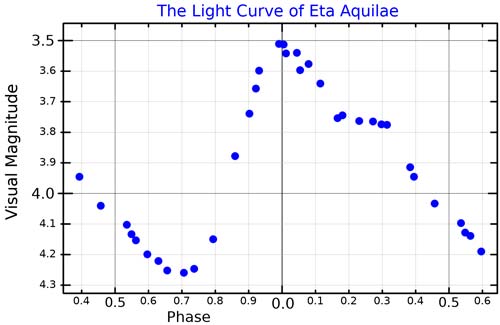Eta Aquilae

A visual band light curve for Eta Aquilae.
Eta Aquilae is the eighth brightest star in the constellation Aquila and one of the sky's most prominent Cepheid variables; its variability was discovered in 1784 by Edward Pigott. Eta Aql lies 8° south of Altair and near one of Aquila the Eagle's talons. Eta also represents the head of the now-defunct constellation Antinous, who was honored in the sky by the Roman emperor Hadrian and depicted as being carried by Aquila.
Eta, like other Type I Cepheids is a luminous yellow-white supergiant. It changes brightness by 0.8 magnitude and back again with precise period of 7 days 4 hours 14 minutes 22 seconds. As it dims, it dips to spectral class G and from a maximum temperature of 6,200 K to 5,300 K.
| visual magnitude | 3.6 to 4.4 |
| absolute magnitude | -3.91 |
| spectral type (at max.) | F6Ib |
| surface temperature (max.) | 6,200 K |
| luminosity | 3,100 Lsun |
| radius | 60 Rsun |
| mass | 7 Msun |
| distance | 1,170 light-years |
| position | RA 19h 52m 28.4s, Dec +1° 0' 20" |


